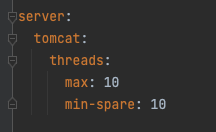Spring Boot 2: Spring WebFlux for Reactive APIs
Spring Boot 2: Spring WebFlux for Reactive APIs
Spring WebFlux is a relatively new library from Spring Boot 2 that provides massive improvement in performance compared to the traditional sync calls. To quote the Spring documentation itself:
Why was Spring WebFlux created?
Part of the answer is the need for a non-blocking web stack to handle concurrency with a small number of threads and scale with fewer hardware resources. Servlet 3.1 did provide an API for non-blocking I/O. However, using it leads away from the rest of the Servlet API, where contracts are synchronous (Filter,Servlet) or blocking (getParameter,getPart). This was the motivation for a new common API to serve as a foundation across any non-blocking runtime. That is important because of servers (such as Netty) that are well-established in the async, non-blocking space.
Further reading: https://docs.spring.io/spring/docs/current/spring-framework-reference/web-reactive.html
In short, Spring Webflux is Spring's answer to reactive web that has been the buzz going on recently. By using single non blocking thread and almost infinite pool space to hold jobs, Spring Webflux avoids the bottleneck of running out of threads due to blocking that most synchronous web calls face.
I created a quick self contained demo of how performant Spring WebFlux can be, you can download the code here: https://github.com/overtakerx/webfluxdemo
Case Study:
Gatling simulating 3000 users increasing linearly over 30 seconds (100 users per second), with the user calling the endpoint 30x, executing on standard, wrong reactive and reactive endpoints.
Outcome:
Gatling output suggests that the normal method call, and the wrong webflux way are slower than the right webflux way with over 80% of the calls ending up above 1200ms.
Count
|
|
Request count
|
90000
|
Min response time (ms)
|
300
|
Max response time (ms)
|
3263
|
Mean response time (ms)
|
2405
|
Std deviation (ms)
|
939
|
Response time 50th percentile (ms)
|
3010
|
Response time 75th percentile (ms)
|
3047
|
Response time 95th percentile (ms)
|
3091
|
Response time 99th percentile (ms)
|
3159
|
Mean requests/sec
|
608.108
|
Response Time Distribution
|
Count
|
%
|
t < 800 ms
|
10466
|
12
|
800 ms < t < 1200 ms
|
4364
|
5
|
t > 1200 ms
|
75170
|
84
|
Failed
|
0
|
0
|
Count
| |
Request count
|
90000
|
Min response time (ms)
| 301 |
Max response time (ms)
|
3132
|
Mean response time (ms)
|
2447
|
Std deviation (ms)
|
902
|
Response time 50th percentile (ms)
|
3021
|
Response time 75th percentile (ms)
|
3051
|
Response time 95th percentile (ms)
|
3080
|
Response time 99th percentile (ms)
|
3099
|
Mean requests/sec
|
604.027
|
Response Time Distribution
|
Count
|
%
|
t < 800 ms
| 8668 |
10
|
800 ms < t < 1200 ms
|
4288
| 5 |
t > 1200 ms
|
77044
| 86 |
Failed
|
0
|
0
|
Count
| |
Request count
|
90000
|
Min response time (ms)
| 301 |
Max response time (ms)
|
2854
|
Mean response time (ms)
|
847
|
Std deviation (ms)
|
461
|
Response time 50th percentile (ms)
|
781
|
Response time 75th percentile (ms)
|
1157
|
Response time 95th percentile (ms)
|
1685
|
Response time 99th percentile (ms)
|
2127
|
Mean requests/sec
|
873.786
|
Response Time Distribution
|
Count
|
%
|
t < 800 ms
| 46151 | 51 |
800 ms < t < 1200 ms
| 23295 | 26 |
t > 1200 ms
| 20554 | 23 |
Failed
|
0
|
0
|
Bonus Case Study:
Gatling simulating 100 users increasing linearly over 30 seconds (roughly 3 users per second), with the user calling the endpoint 30x, executing on deferredresult and callable endpoints.
Bonus Outcome:
Gatling output suggests that the Callable method call suffers horribly even with only a total of 3000 requests, and DeferredResult method call is even worse than that.
Count
| |
Request count
|
3000
|
Min response time (ms)
| 302 |
Max response time (ms)
|
2519
|
Mean response time (ms)
|
1719
|
Std deviation (ms)
|
731
|
Response time 50th percentile (ms)
|
2152
|
Response time 75th percentile (ms)
|
2270
|
Response time 95th percentile (ms)
|
2366
|
Response time 99th percentile (ms)
|
2433
|
Mean requests/sec
|
23.622
|
Response Time Distribution
|
Count
|
%
|
t < 800 ms
| 583 | 19 |
800 ms < t < 1200 ms
| 177 | 6 |
t > 1200 ms
| 2240 | 75 |
Failed
|
0
|
0
|
Count
| |
Request count
|
3000
|
Min response time (ms)
| 302 |
Max response time (ms)
|
26483
|
Mean response time (ms)
|
7515
|
Std deviation (ms)
|
5341
|
Response time 50th percentile (ms)
|
6677
|
Response time 75th percentile (ms)
|
11697
|
Response time 95th percentile (ms)
|
15143
|
Response time 99th percentile (ms)
|
23963
|
Mean requests/sec
|
9.615
|
Response Time Distribution
|
Count
|
%
|
t < 800 ms
| 139 | 5 |
800 ms < t < 1200 ms
| 75 | 3 |
t > 1200 ms
| 2786 | 93 |
Failed
|
0
|
0
|
Using Webflux
Do note that webflux has different set of lambda than java's standard lambda and it sort of enforces to maximize the use of lambda, here is an example of a lambda that fetch a website content, store it in database and transform it and send a transformed response:
return WebClient.create(hostUrl).get() .uri(uri) .retrieve() .bodyToMono(Response.class).flatMap(resp -> { resp.setQueryData(queryData);
return dbRepository.save(resp);
})
.map(resp -> NewResponse.builder().id(resp.getId()).build()
);



Comments
Post a Comment